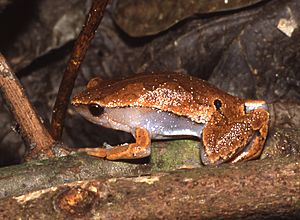Bolivian bleating frog facts for kids
Quick facts for kids Bolivian bleating frog |
|
|---|---|
 |
|
| Conservation status | |
| Scientific classification | |
| Synonyms | |
|
Chiasmocleis boliviana Parker, 1927 |
The Bolivian bleating frog, also called the Amazon sheep frog, is a type of frog. Its scientific name is Hamptophryne boliviana. These frogs belong to the Microhylidae family. You can find them in the northern and western parts of the Amazon basin. This includes countries like Bolivia, Brazil, Colombia, Ecuador, French Guiana, Guyana, Peru, Suriname, and Venezuela. Scientists think there might be more types of these frogs than we currently know.
About the Bolivian Bleating Frog
Adult male frogs from Peru are about 34 to 39 millimeters long. Female frogs are a bit bigger, measuring 39 to 44 millimeters. Some groups of these frogs might be smaller.
Their bodies are quite strong. Their fingers and toes have special flat tips. They do not have extra skin flaps or webbing between their digits.
The frog's back is tan with a large brown spot in the middle. It often has a light, creamy white stripe down its back. The sides of its body, head, and hidden parts of its legs are dark brown. Male frogs have a dark brown throat. The belly and the underside of the back legs are creamy white. They have brown spots or patterns on these areas. The frog's eyes are pale bronze with thin black lines.
Where They Live and How They Are Protected
These frogs live in tropical rainforests. You can find them in both old and new forests. They usually stay in the leaves on the ground. They live in places up to 400 meters above sea level.
Bolivian bleating frogs are active at night. They eat ants. They find their food on the ground or on tree trunks and branches. They lay their eggs in ponds and flooded areas. This happens in the forest after heavy rains.
This frog species is found in many places. However, it is not very common in most of these areas. Scientists have not found any major threats to these frogs. This means they are not currently in danger.
Frog Behavior and Friends
The Bolivian bleating frog has been seen living close to a large tarantula called Xenesthis immanis. This tarantula is also known as the Colombian lesser black tarantula.
It is possible that these two animals help each other. This is called a mutualistic relationship. The spider might protect the frog and its eggs from animals that want to eat them. In return, the frog might protect the spider's eggs from ants. This kind of helpful relationship has been seen between another frog, Chiasmocleis ventrimaculata, and the same type of tarantula.


